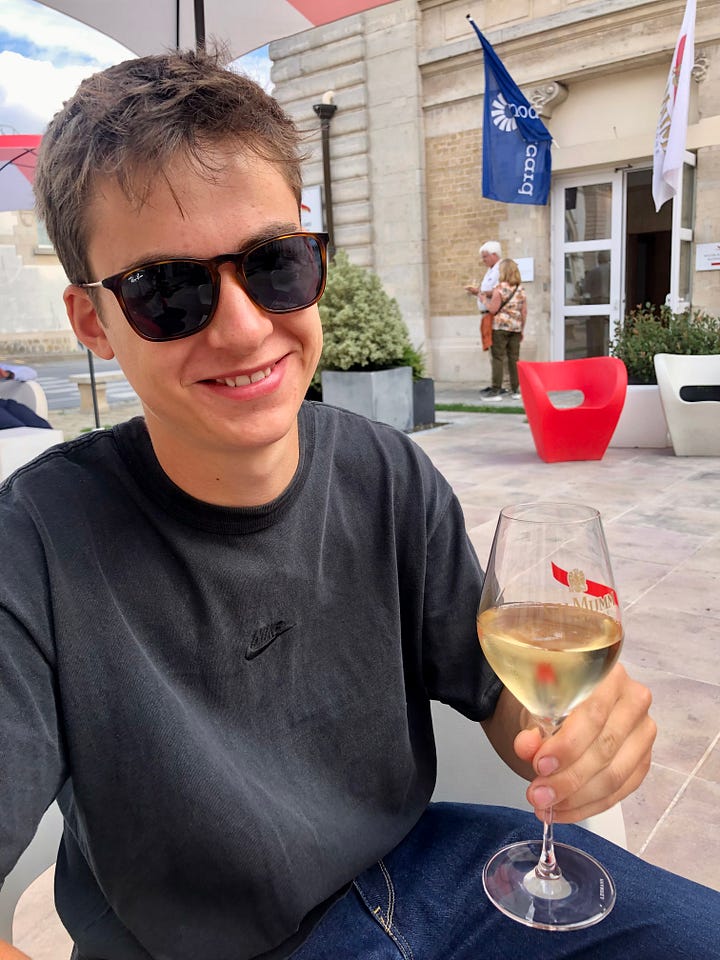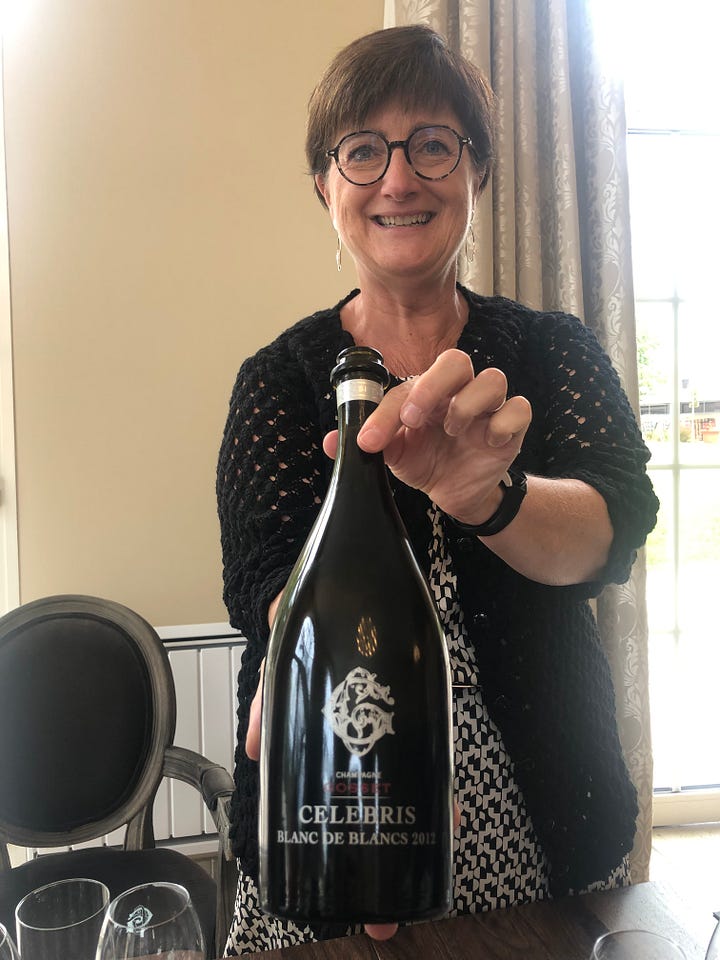A champagne education for Max
On the road in Champagne with my beer-drinking student son. Plus: what I've been drinking this week


SINCE toddlerhood my son, Max, has had a noticeably sharp sense of smell and taste. It hadn’t until recently been deployed in wine, Max (now 20) being a beer drinker. Nevertheless, it wasn’t hard to persuade Max to travel to Champagne with me earlier this autumn. But could I educate him about champagne in just two days there?
As we sped down the A26 from Calais I explained champagne’s production process, conscious that this would all make more sense when we had stacks of crown-capped bottles and disgorging machinery in front of us. I was also keen to give Max a sense of the terroir and the variations in styles across the region – so I had arranged visits at a varied range of producers.
We stopped first at GH Mumm in Reims, one of the industry’s two main centres and much bigger than entirely champagne-dominated Epernay. I’m not especially fond of Mumm’s slightly average Cordon Rouge, though it’s not bad. More important for a first visit, it’s worth starting off at a big house because of their slick presentations on champagne’s history and production. And though tours at some are now very pricey, Mumm is one of the slightly more reasonable at €28 a head. Plus, the very French grandeur of the grandes marques is an intrinsic part of this region, even if not the whole story.
But despite Mumm talking up of their wines’ pinot noir-dominant character, for me they’re not a great example of that. For those, you need the Montagne de Reims, the higher ground to the south of the city before the escarpment falls towards the river Marne. So our next stop was the village of Louvois, south east of Reims, and Champagne Guy de Chassey.
With only 9.5 hectares of vines, Guy de Chassey make around 35,000 bottles a year, selling the rest of their grapes to bigger houses – a common business model for smaller growers. Their vineyards are in Louvois and Bouzy, two of the 17 Grand Cru villages, classified as producing the best grapes.
But they use a fair amount of chardonnay too in most of their cuvées: the Grand Cru 2015, made from 50/50 pinot noir/chardonnay, is particularly gorgeous. We tasted seven cuvées in all, discussing different blends of grapes, dosages (the amount of sugar added when champagne is corked) and the winemaking. It was a fine second lesson for Max.
In Epernay, we walked up the Avenue de Champagne, gazing at the vast chateaux behind wrought iron gates. With dinner, we drank Didier Marc’s Grand Réserve Brut NV from Fleury-la-Rivière, in the heart of the Marne valley to our west. It was another style for Max to sample: typically for the valley, 70 per cent pinot meunier, floral and fruity.
An early start next morning – this was harvest time, and we needed to visit before things got too busy – took us south to Champagne Michel Rocourt in Le Mesnil-sur-Oger. Le Mesnil sits in the heart of the Côte des Blancs, dominated by chardonnay vines; the vineyards around were dotted with groups of pickers. It is also a Grand Cru village, though some of Rocourt’s vineyards lie in lesser (but still prized) Premier Cru zones.
Rocourt make only around 30,000 bottles a year, selling the remaining 2,500 litres of must to the likes of Champagne Duval-Leroy. It’s classic (all-chardonnay) Blanc de Blancs, very fresh and crisp: another style for Max.
For our last visit, it was time to go upmarket with a tasting back in Epernay at Gosset. The house is on an entirely different scale to grower champagnes, though much smaller than Moët et al, releasing around one million bottles a year. They are different too in buying in all their fruit (as must). And they’re the oldest house, founded in 1584, before champagne was even fizzy (it became reliably effervescent only in the early nineteenth century.)
I’ve long been a fan of Gosset’s Grande Réserve, a rich and complex champagne and for my money one of the best non-vintages. But we swiftly moved up the range from that, with the honeyed, unusual Blanc de Blancs NV; the pale, very long 12 Ans de Cave à Minima rosé NV; and top cuvée, the incredibly complex Celebris Blanc de Blancs 2012. Max looked impressed.
On our way home we stopped off in Arras. I ordered us glasses of André Bergère Origine Brut NV: we sniffed and sipped. “What do you think?” I asked.
“Majority chardonnay, touch of oak?”
“Well done, Max!” I said. And thought: bloody hell, I might have created a champagne monster here.
Best Champagne houses to visit
In the 23 years since I first tasted here, the region’s approach to wine tourism has been transformed. Now, not only most of the grandes marques but dozens of smaller growers offer tours and tastings, many bookable online at Champagne Booking, Rue des Vignerons and the Châlons-en-Champagne tourist office.
Alfred Gratien, Epernay - I love Gratien’s beautifully balanced champagnes, and the pleasant bar at their cave offers a series of very fairly priced flights for tasting.
Mercier, Epernay - Mercier, now part of the LVMH group, was one of the first big houses to get in on wine tourism, and they do it well. They’re very proud of their little train that transports visitors through the cellars - and it is quite fun.
Pol Roger, Epernay - unless you're in the wine trade or media, your chances of arranging a visit here are low, but it's worth the effort. Deep cellars, rows and rows of riddling racks - and wow, that champagne.
What I’ve been drinking this week
Feudo Antico Tullum Rosso 2018 - I’ve written before about the joys of Italian regionalism and the country’s patchwork of little-known wines. Such is the DOCG (I mean, really?) of Tullum, near the town of Tollo, close to the Adriatic coast in Abruzzo. This is essentially a classy Montepulciano d’Abruzzo, brimming with plush bramble and cherry fruit: cries out for pasta with a tomatoey sauce (was Wine Society, £14.50.)
Gabo do Xil Mencía 2020, Valdeorras - I’ve long admired Telmo Rodriguez’s Gabo do Xil godello, my favourite example of inland Galicia’s greatest white grape - but I hadn’t until this week tried his red. This is a brilliant mencía, full and long but with beautifully balanced acidity (NY Wines, Ibérica online, Vinissimus, from £14.45.)
Domaine Ameztia blanc 2018, Irouléguy - I visited the tiny, sleepy French Pyrenean appellation of Irouléguy last August. I was particularly taken with this white, a pretty typical blend for the area of 70/30 per cent gros/petit manseng: smoky, savoury with an almost oily weight to it, with balancing freshness. Unusual. (N/A UK; ex-cellar about €20.)
Transparency disclosure: my Gosset tasting was courtesy of the producer, as was a previous visit to Pol Roger.




